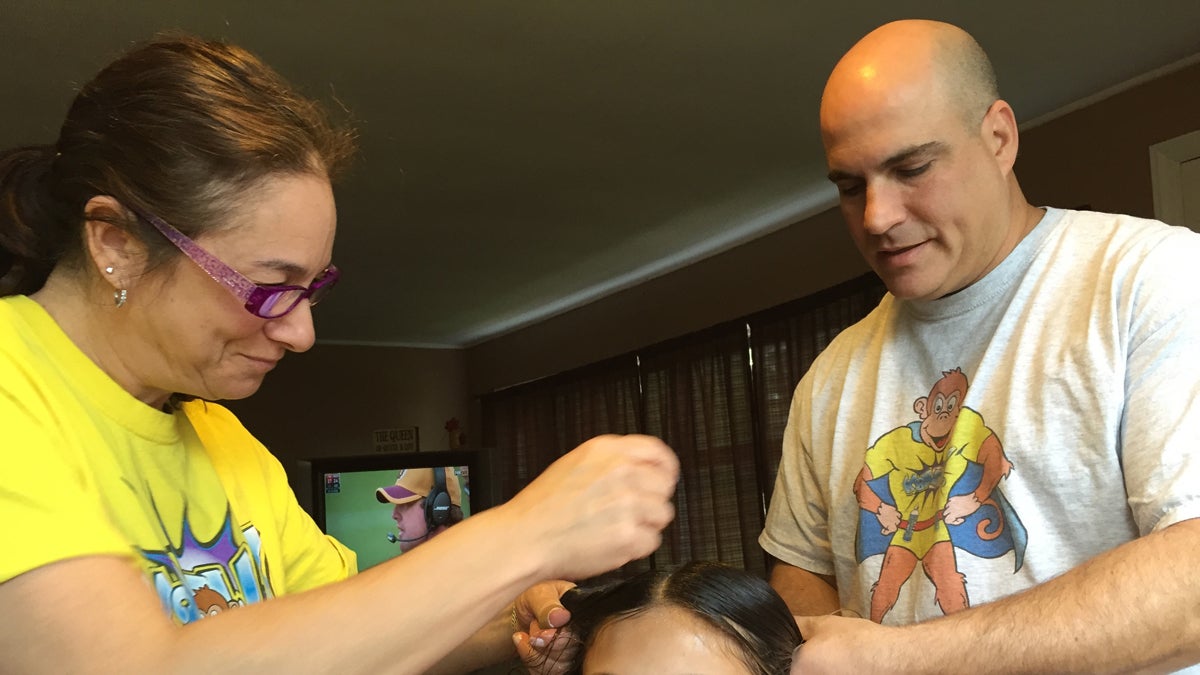‘Super lice’ are outliving normal treatments, but don’t panic
Listen
Ilene and Ed Steinberg treat lice cases throughout the Philadelphia region. (Maiken Scott/WHYY)
Head lice have upped their game — recent research confirms that many of them have become resistant to most of the potions we use to kill them.
Sometimes just talking about lice makes people’s heads itch, and this additional news has sent some parents into a panic.
But if lice are your business, then business is good.
Ilene and Ed Steinberg run The Center for Lice Control. They treat heads all over the Philadelphia region.
One of their recent clients, 9 year old Alyssa McCabe, had likely had lice for a while. Her mother, Crystal Morse, called the Steinbergs after finding live bugs in her daughter’s hair.
Ilene quickly confirmed that it was indeed lice, and applied a treatment that looks like conditioner. Then she started combing out dead lice and their eggs. Alyssa seemed utterly grossed out and fascinated at the same time.
Killing lice for a living is a bit of a strange turn professionally. Ilene used to be a pastry chef, but she spent summers working in a overnight camp for kids. A few years ago, they had a nasty head lice infestation that they couldn’t get rid of. She noticed that none of the products they were using were working.
“We kept finding live bugs,” she recalled. “We kept finding live nits, and we knew that what we were doing was not ending the infestation.
By the end of that summer, Ilene was fascinated with lice, and determined to find new ways to get rid of them.
Science just confirmed the observation she made back then — head lice have mutated genetically in such a way that the most commonly used insecticides can no longer enter their bodies. Most over-the-counter treatments contain Permethrin, or pyrethroids — insecticides that used to cause the lice to convulse and die. Now, they are pretty useless.
“You will kill a few lice but not many, chances are you are going to have lice hatch out of eggs that are resistant and they’ll just keep on going,” explained John Clark, a professor of environmental toxicology at the University of Massachusetts in Amherst.
Clark’s lab collected lice from all over the country and checked them for genetic mutations.
“In all 48 states where we looked, we have found these mutations, and the relative frequency is 96 percent, and the lice are then resistant to the Permethrin or pyrethroids that are used in the over the counter products,” he says.
This is no big surprise. Current treatments have been in use for decades, and they have been overused.
Ilene Steinberg, who goes by “Ilene Lice Queen” on Twitter says many families she meets have already tried several other treatments, and the lice just keep coming back.
She also finds that there’s a lot of misinformation about lice, and how you get them.
“Over 95 percent of lice infestations come from head to head contact, and hair to hair contact. A very small amount comes from sharing brushes, hats and helmets.”
So, lice can spread when we hug, cuddle, take selfies and so on.
Ilene asked Alyssa about friends she has had head-to-head contact with, and the fourth-grader comes up with a surprisingly long list. She has been to a lot of sleepovers lately, and she’s also a cheerleader.
“Me and my friend yesterday, we were doing our cheer, and we have to make a heart with our hands and put our heads together, so she could have gotten it,” she recalled. Ed Steinberg tells Alyssa’s mom to call that friend up, and tell her about the potential exposure.
Steinberg has developed her own formula to suffocate lice — it’s made with olive oil and a silicone, among other things. She refined her recipe much like a baker would, taking home live lice from appointments and treating them with different mixtures until she had something that worked reliably.

Ilene the lice queen combs through Alyssa’s hair. (Maiken Scott/WHYY)
When she is done combing the dead bugs and eggs out of Alyssa’s hair, she explains a follow-up treatment that should be applied six days later, to prevent any nits that were potentially left behind from hatching.
The Steinberg’s try to reassure the family that even though Alyssa had a pretty serious infestation, this is no reason to panic – or to start on a massive cleaning marathon.
The nits – the eggs of lice, are glued to the hair shaft and don’t move. Lice don’t like to leave a head, they usually stay put, they don’t jump or fly. They can’t stay alive for very long once off a head. So, pregnant females just happening to be on the loose are the only real cause for concern.
The clean up instructions Ilene hands out are fairly simple: Put bedding, recently worn clothes or stuffed animals into the dryer for a half an hour. Sterilize the brushes and hair accessories in hot water. Vacuum couches, chairs, or car seats, or use a lint roller. Nothing crazy.
Schools are often seen as the place where lice infestations get their start, but Beth Mattey, president of the national association of school nurses says that’s not the case:
“It’s a community issue, it’s not a school issue,” she explained.

Beth Mattey, the president of the national association of school nurses, says that lice is a community problem, not just a school problem. (Maiken Scott/WHYY)
Mattey works in Wilmington, Delaware, and has been a school nurse for over two decades. She says school usually just happens to be the place where lice are detected, after a teacher sends a head-scratching kid to the nurse’s office. Lice are more commonly found in elementary school.
She says a lot of schools have lice policies that are not rooted in science.
“We have been saying for several years that children do not need to go home, but we haven’t gotten the message out. The newest study from CDC that came out showed that 80 percent of the schools they surveyed still exclude for head lice.”
She says kids who have lice should stay for the rest of the day, then go home and get treated, and then come back the next day.
This can be a very unpopular approach among some parents who fear their kid will be at higher risk for getting lice this way. But lice experts counter that chances are, by the time a school nurse detects an infestation, it’s been there for a while already.
Mattey says sending kids home or keeping them home for days doesn’t prevent infestations, but it results in lost school days and could create problems for working parents.
WHYY is your source for fact-based, in-depth journalism and information. As a nonprofit organization, we rely on financial support from readers like you. Please give today.




